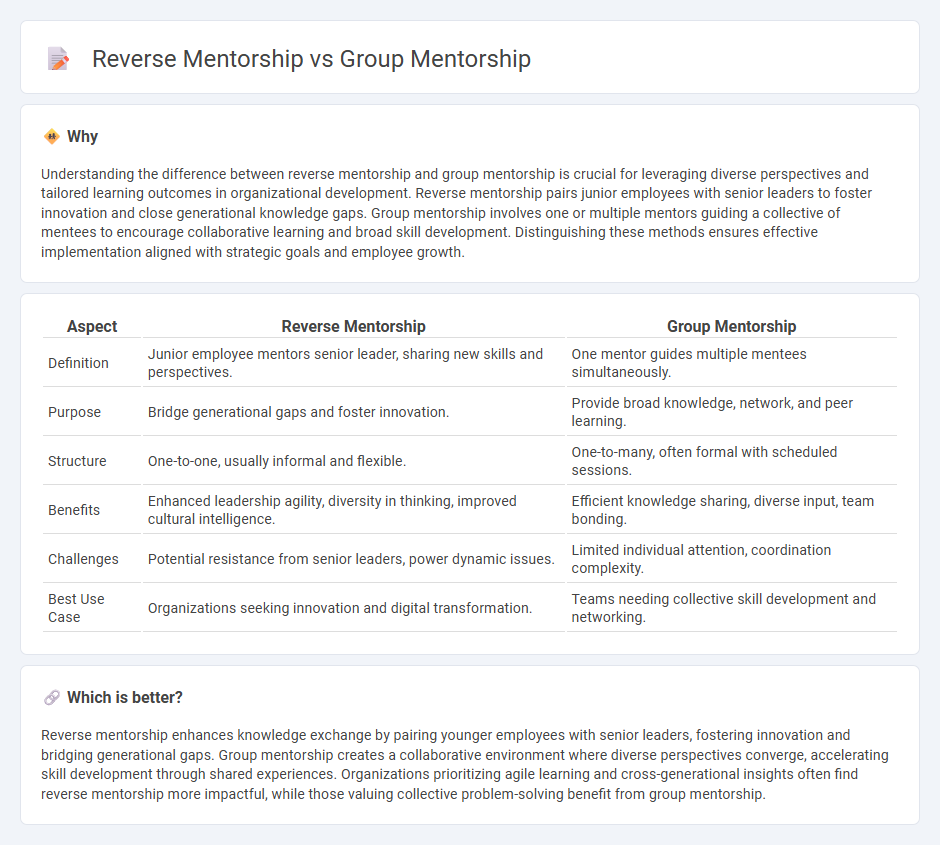
Reverse mentorship flips traditional roles by having younger employees share knowledge and fresh perspectives with senior leaders, fostering innovation and bridging generational gaps. Group mentorship involves multiple mentors and mentees collaborating to exchange diverse insights, accelerate learning, and build professional networks. Explore how these dynamic mentorship models can transform organizational growth and leadership development.
Why it is important
Understanding the difference between reverse mentorship and group mentorship is crucial for leveraging diverse perspectives and tailored learning outcomes in organizational development. Reverse mentorship pairs junior employees with senior leaders to foster innovation and close generational knowledge gaps. Group mentorship involves one or multiple mentors guiding a collective of mentees to encourage collaborative learning and broad skill development. Distinguishing these methods ensures effective implementation aligned with strategic goals and employee growth.
Comparison Table
| Aspect | Reverse Mentorship | Group Mentorship |
|---|---|---|
| Definition | Junior employee mentors senior leader, sharing new skills and perspectives. | One mentor guides multiple mentees simultaneously. |
| Purpose | Bridge generational gaps and foster innovation. | Provide broad knowledge, network, and peer learning. |
| Structure | One-to-one, usually informal and flexible. | One-to-many, often formal with scheduled sessions. |
| Benefits | Enhanced leadership agility, diversity in thinking, improved cultural intelligence. | Efficient knowledge sharing, diverse input, team bonding. |
| Challenges | Potential resistance from senior leaders, power dynamic issues. | Limited individual attention, coordination complexity. |
| Best Use Case | Organizations seeking innovation and digital transformation. | Teams needing collective skill development and networking. |
Which is better?
Reverse mentorship enhances knowledge exchange by pairing younger employees with senior leaders, fostering innovation and bridging generational gaps. Group mentorship creates a collaborative environment where diverse perspectives converge, accelerating skill development through shared experiences. Organizations prioritizing agile learning and cross-generational insights often find reverse mentorship more impactful, while those valuing collective problem-solving benefit from group mentorship.
Connection
Reverse mentorship leverages the fresh perspectives of younger employees to guide senior leaders, while group mentorship fosters collaborative learning among diverse participants; both methods enhance knowledge sharing and innovation within organizations. Integrating reverse mentorship into group mentorship programs encourages multigenerational dialogue, breaking down hierarchical barriers and fostering mutual growth. This synergy increases employee engagement, accelerates skill development, and strengthens leadership capabilities across all levels.
Key Terms
Knowledge Sharing
Group mentorship facilitates knowledge sharing by enabling multiple participants to exchange diverse insights and experiences simultaneously, fostering collaborative learning. Reverse mentorship flips traditional roles, allowing younger employees to share fresh perspectives and digital expertise with senior leaders, enhancing organizational adaptability. Discover how these mentorship approaches optimize knowledge transfer within your team by exploring their unique benefits.
Power Dynamics
Group mentorship traditionally involves experienced mentors guiding less experienced mentees, reinforcing established power dynamics and hierarchical knowledge transfer. Reverse mentorship flips this model, empowering junior employees to share insights with senior leaders, thereby challenging conventional authority and fostering mutual learning. Explore the impact of these contrasting power dynamics to enhance organizational growth and innovation.
Diversity of Perspectives
Group mentorship fosters diversity of perspectives by bringing together multiple experienced mentors from varied backgrounds, enriching discussions with multifaceted insights and broadening mentees' understanding. Reverse mentorship, where younger or less experienced individuals mentor senior leaders, challenges traditional views and introduces fresh, often underrepresented viewpoints that enhance organizational inclusivity. Explore how combining these mentorship models can maximize diverse perspectives and drive innovative growth.
Source and External Links
8 Steps to Start a Group Mentoring Program - This webpage provides a step-by-step guide on how to initiate and manage a group mentoring program, including different models and their applications.
Group Mentoring: 9 Steps To Start a Group Mentoring Program - Offers a comprehensive approach to establishing a group mentoring program, highlighting its benefits and steps for implementation.
Group Mentoring Guide: Benefits, Tips and How to Implement - Provides insights into the setup and advantages of group mentoring, especially in scenarios where mentors are limited.
 dowidth.com
dowidth.com